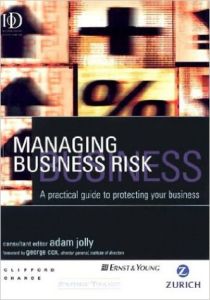Join getAbstract to access the summary!

Join getAbstract to access the summary!
Adam Jolly
Managing Business Risk
A Practical Guide to Protecting Your Business
Kogan Page, 2003
What's inside?
Imagine getting ranking corporate experts together to teach you the best risk management practices. Well, here they are.
Recommendation
This advertiser-supported book is unusual, and not only because the reader may find it surprising to find advertising pages in a book. Offering various levels of commentary and analysis on a spectrum of risks and risk management approaches, the editor has brought together a diverse group of executives and experts from firms that provide risk management services. Sections cover value and cost, change and continuity, governance and control, integrity and accountability, knowledge and systems, financial risks, legal considerations and workplace and employment practices. While some pieces do have a promotional bent, several are quite sophisticated and merit careful reading. The section on Sarbanes-Oxley implementation, written by an Ernst & Young senior manager, is certainly timely. It is also distinctive, since many of the book’s essays focus on Europe, particularly the United Kingdom. The chapter on managing intellectual property risks, written by two experts from Clifford Chance, also offers tips that are well worth remembering. In sum, getAbstract.com recommends this somewhat surprising package of useful and relevant information.
Summary
About the Author
Adam Jolly was the consultant editor for this collection of information from leading authorities at international companies, including Lloyd’s of London, Oxford Metrica, Zurich Risk Services, Ernst & Young, Strategic Thought, Ltd., The Chartered Institute of Purchasing & Supply, Continuity Systems, Ltd., Clifford Chance, British Standards Institution, Control Risks Group, Hiscox Insurance Company, ACE European Group, Bibby Financial Services and the Futures and Options Association.
















Comment on this summary